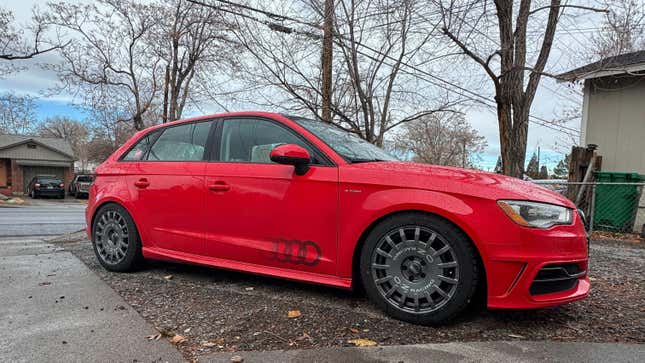My cute little strawberry-colored hybrid is all grown up. This week I finally finished installing the lowering springs on my 2016 Audi A3 E-Tron daily driver and I couldn’t be happier. I’ve been driving lowered vehicles as my everyday machines for about 15 years, and sitting just a little bit lower than factory makes my heart sing. A rather simple coil spring swap and some cool wheels is all most cars need to look their best. The aesthetic and handling benefits of lowering a car more than outweigh the minor decrease in comfort experienced with lower and stiffer springs.
Is lowering your daily driver right for you? Let’s get in to it.

Installing lowering springs is a pretty straightforward DIY task if you’re at least moderately handy with a wrench. The rear springs went in super easily once I figured out the proper method of disconnecting the lower control arm, but the fronts fought me a little more. On this particular car it involved extracting the front strut from the upright assembly, and in order to get the upright low enough to remove the strut from its clamp meant unbolting the ball joint, disconnecting the CV axle and swaybar, and lightly rocking the hub while pushing downward. For some reason the driver’s side took about two hours, but the passenger’s side took 20 minutes. Sometimes that’s how it goes.

A lot of people are afraid of this style of McPherson strut spring compressor. If you treat them right and don’t stick your hands inside the tensioned spring, you’re probably fine. I’ve never personally seen one fail, but there is definitely a lot of potential energy bound up in the above image and if poorly handled could shoot your eye out, kid. I find that using an impact gun is the easiest way to handle these things. Line them up correctly on the spring and send it, but make sure you’re applying even ugga duggas to both sides. Once the spring is compressed you can remove the top nut and slowly loosen the spring back to its full height. Pop the new spring on, re-install the strut top, and Robert’s your mother’s brother.

If you have been following this suspension saga, which I somehow managed to stretch out into three separate blogs, you’ll know that I seriously fucked up when I finished the driver’s side front corner. A $170 rebuilt caliper from NAPA put everything right again, and the install and bleeding process was a total breeze. Instead of running a power bleeder or having my wife push pedals all afternoon, I simply cracked the bleeder valve on the new caliper, topped up the primary cylinder with fresh Motul Resting Bitch Face from my stash and let gravity do the job for 15 minutes or so. Then I hooked up the one-person bleeder bottle to the valve and gave it a single pump on the pedal to confirm all the air had been released. I was really worried about it, but it could not have gone more smoothly.

With that repair out of the way I was able to get the car back on four wheels for the first time in three days, and with rear ride height matching the front for the first time in a couple weeks. Oh baby, that looks fantastic!
There are tons of options out there in the world, but I chose to go with ECS Tuning’s dual rate lowering springs for MQB chassis. While they’re explicitly for Mk7 and MK8 Volkswagen GTI fitment, the A3 is more or less a GTI with fancy leather interior. The E-Tron is essentially the same car as a Euro-market plug-in hybrid Volkswagen GTE, and everything seems to swap over without much issue. These springs are a good blend of comfort and sporty, and better than that, they’re inexpensive and I’m a cheapskate.

After a few days of driving this car on the new springs, I have definitely made some concessions to comfort in favor of aesthetics. These springs make the car ride about 1.4 inches lower than stock, which means that taller speed bumps cause the car to scrape lightly. Bumps and highway expansion joints are a little harsher than before, but I’ve definitely driven stiffer and worse cars on factory suspension. If you are coming from basically any sports car on stock suspension, this will feel similar.
Driving a lowered car is a mindset thing. Everything is a trade-off, and stock suspension dynamics are built for the lowest common denominator. Audi’s suspension engineers had to build a car that was as comfortable as possible for as many people as possible, all over the world. A ride height like this from the factory would have been met with distaste from seniors who find it difficult to get out of the driver’s seat, or normies who want a pillowy ride. If your priorities, like mine, are aesthetics and handling, this is an easy trade off. Beauty is pain, as they say.
Because we’re in the depths of the winter doldrums, I won’t have a real opportunity to test out the handling until I get the summer wheel and tire package back on the car. Maybe I’ll have the sway bar situation figured out by then, too. I’ll be sure to offer and update once I do.


